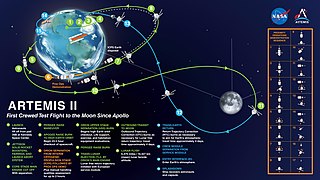Related Research Articles

Free-space optical communication (FSO) is an optical communication technology that uses light propagating in free space to wirelessly transmit data for telecommunications or computer networking. "Free space" means air, outer space, vacuum, or something similar. This contrasts with using solids such as optical fiber cable.
The Space Test Program (STP) is the primary provider of spaceflight for the United States Department of Defense (DoD) space science and technology community. STP is managed by a group within the Advanced Systems and Development Directorate, a directorate of the Space and Missile Systems Center of the United States Space Force. STP provides spaceflight via the International Space Station (ISS), piggybacks, secondary payloads and dedicated launch services.
The European Data Relay System (EDRS) system is a European constellation of GEO satellites that relay information and data between satellites, spacecraft, UAVs, and ground stations. The first components were launched in 2016 and 2019.
The EELV Secondary Payload Adapter (ESPA) is an adapter for launching secondary payloads on orbital launch vehicles.

The Laser Communications Relay Demonstration (LCRD) is a NASA mission that will test laser communication in space for extremely long distances, between Earth and geosynchronous orbit.

Artemis 2 is a scheduled mission of the NASA-led Artemis program. It will use the second launch of the Space Launch System (SLS) and include the first crewed mission of the Orion spacecraft. The mission is scheduled for no earlier than September 2025. Four astronauts will perform a flyby of the Moon and return to Earth, becoming the first crew to travel beyond low Earth orbit since Apollo 17 in 1972. Artemis 2 will be the first crewed launch from Launch Complex 39B of the Kennedy Space Center since STS-116 in 2006.

Laser communication in space is the use of free-space optical communication in outer space. Communication may be fully in space or in a ground-to-satellite or satellite-to-ground application. The main advantage of using laser communications over radio waves is increased bandwidth, enabling the transfer of more data in less time.
NanoAvionics Corp is a small satellite bus manufacturer and mission integrator founded as a spin-off from Vilnius University, Lithuania in 2014.

Kepler Communications Inc. is an international satellite telecommunications company based in Toronto, Ontario, Canada, with presence in the UK and the USA. The company's stated mission is to create the internet for space and allow-in-space communications for the future space economy. It has also worked on building a satellite network for IoT communication systems.

1KUNS-PF was the first Kenyan-owned satellite. The cubesat was developed and assembled by the University of Nairobi for the Kenya Space Agency, with technical support provided by Japan's Aerospace Exploration Agency. The spacecraft was deployed from the International Space Station are being launched by a SpaceX Falcon 9 rocket.
IRVINE02 is an educational 1U CubeSat mission that gives high school students the experience of building, testing, and controlling a nano-satellite to develop interest and talent in the science and engineering fields. The mission features the second orbital ion electrospray thruster developed by Accion Systems. Beyond the thruster, IRVINE02 utilizes magnetorquers, deployable solar arrays, a GPS unit, and a miniaturized 1.4 Watt blue laser communication module to transmit pictures and data back to Earth. The magnetorquers and the laser are both developed by the Ecuadorian Space Agency. This laser made IRVINE02 the first 1U cubesat to fly with an orbit-to-ground laser communications device. It transmits data and pictures to the Earth much faster than radio.
PT Pasifik Satelit Nusantara (PSN) is a private Indonesian satellite telecommunications company.
Lincs is an abbreviation for Lincolnshire, England.
NASA's Pathfinder Technology Demonstrator (PTD) Project is a series of tech demonstrations of technologies aboard a series of nanosatellites known as CubeSats, providing significant enhancements to the performance of these versatile spacecraft. Each of the five planned PTD missions consist of a 6-unit (6U) CubeSat with expandable solar arrays.
Swarm Technologies, Inc. is a company building a low Earth orbit satellite constellation for communications with Internet of things (IoT) devices using a store and forward design. Social Capital partners Jay Zaveri and Arjun Sethi incubated and seed funded Swarm, Craft Ventures was an early investor. On 16 July 2021 Swarm entered into an agreement to become a wholly owned subsidiary of SpaceX.
EnduroSat AD is a Bulgarian aerospace manufacturer headquartered in Sofia. It was founded in 2015 by Raycho Raychev. The company designs, builds, and operates CubeSats and Nanosatellites for commercial and scientific missions and is developing inter-satellite linking and data applications. EnduroSat was nominated as one of the top 5 small satellite start-ups.

The Space Development Agency (SDA) is a United States Space Force direct-reporting unit tasked with deploying disruptive space technology. A primary focus is space-based missile defense using large global satellite constellations made up of industry-procured low-cost satellites. The SDA has been managed by the United States Space Force since October 2022. By February 2024 the SDA had 33 satellites on orbit. SDA targets to have at least 1,000 satellites in low Earth orbit by 2026.

SpaceX CRS-27, also known as SpX-27, was a Commercial Resupply Service mission to the International Space Station (ISS) launched on 15 March 2023. The mission was contracted by NASA and was flown by SpaceX using Cargo Dragon C209. This was the seventh flight for SpaceX under NASA's CRS Phase 2.
Bulent Altan is a Turkish-American aerospace executive and engineer, known for his significant contributions to SpaceX, an American aerospace manufacturer and space transportation services company headquartered in Hawthorne, California. He was also CEO of laser communications manufacturer Mynaric and is founding partner of venture capital firm Alpine Space Ventures.